Election 2002 Maryland Makes Its Bed
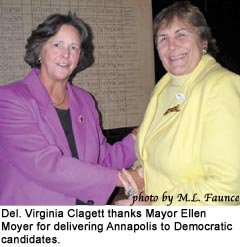 Like the nation, Election Night ’02 in Chesapeake Country reflected an America that defines itself as a pound more Republican than Democrat. A sprinkling of races in both Anne Arundel and Calvert counties balanced so precariously that absentee ballots will tip the scales. In many more, victory added up a vote at a time.
Like the nation, Election Night ’02 in Chesapeake Country reflected an America that defines itself as a pound more Republican than Democrat. A sprinkling of races in both Anne Arundel and Calvert counties balanced so precariously that absentee ballots will tip the scales. In many more, victory added up a vote at a time.
In the rainy late hours of Nov. 5, you could feel the weight of every vote. At trendy restaurants in Anne Arundel County — Harry Browne’s, Jillians, Breeze, Yellow Fin — and civic halls in Calvert — the Prince Frederick Fire Hall and the Masonic Lodge — crowds of partisans leaned into the news called in on cell phones by party workers. Hopefuls flinched or exhaled a lungful of relief as numbers for precinct after precinct were reported. Most counts these days are computer assisted, so futures were made or broken with the push of the tabulation button.
Jubilant Anne Arundel County Republicans in Districts 30 and 33 blended into the surge of everynight American life at Jillians, an upscale pool and game parlor. There, amid the crack of ivory pool balls and the haze of smoke, players at politics were braced by the statewide pattern of victory. Losers — Nancy Almgren, Mike Collins and Phil Bissett — could grin as they bore personal defeat.
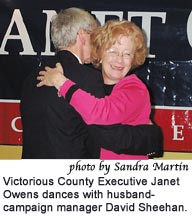 Trailing incumbent County Executive Janet Owens by some 4,000 votes at 10:45pm, Bissett allowed “we’re not where we wanted to be” but seemed undaunted. “I’ve got two choices. In the morning, I can wake up happy or miserable. I’m sleeping in but, win or lose, I’m waking up happy.”
Trailing incumbent County Executive Janet Owens by some 4,000 votes at 10:45pm, Bissett allowed “we’re not where we wanted to be” but seemed undaunted. “I’ve got two choices. In the morning, I can wake up happy or miserable. I’m sleeping in but, win or lose, I’m waking up happy.”
First-time winners, on the other hand, felt the weight of the job ahead. “I’m numb,” said firefighter Bob Costa on finding himself by 1,483 votes the delegate-elect for District 33B. “Rather than jubilant, I’m humbled.”
‘Big’ Ed Reilly chose the same word, “humbled,” to describe his 55 to 45 percent victory over Bill Rinehart to take over the late John Klocko’s job as councilman for the county’s 7th District. “I’m a rookie,” Reilly said — before quickly adding, “But I’m sure I’m up to the challenge.”
District 30 Democrats savored a victory party of their own, but it ended too quickly. At Loews Annapolis Hotel’s lushly minimal new restaurant Breeze, Mayor Ellen Moyer crowed that “We delivered every Democratic candidate in the city.” Even Kathleen Kennedy Townsend — who will retire as Maryland’s lieutenant governor, not its governor — took Annapolis, polling 6,481 votes to statewide victor Bob Ehrlich’s 5,727.
 But when the party moved over to Harry Browne’s, the tide changed. “Townsend has gotten her butt whipped and the ABCD team — Sen. John Astle and delegates Michael Busch, Virginia Clagett and Dick D’Amato — are in a real dogfight with the Republicans,” said Steve Carr.
But when the party moved over to Harry Browne’s, the tide changed. “Townsend has gotten her butt whipped and the ABCD team — Sen. John Astle and delegates Michael Busch, Virginia Clagett and Dick D’Amato — are in a real dogfight with the Republicans,” said Steve Carr.
By 10pm, the District’s AB and C were safe. Clagett, who said “I’ve expected to lose every election for 28 years,” had once again proved herself wrong.
But D’Amato’s seat hung in the balance. “I’m worried about Dick,” said Astle. “It’s very close.”
So close that D’Amato — who’d left early to manage defeat or celebrate victory on his own — woke Nov. 6 to lingering suspense. The precinct count gave his opponent, Herb McMillan, victory by 288 votes. But with some 6,000 absentee ballots to be counted Nov. 7, that race was “too close to call,” said Anne Arundel election board director Barbara Fisher.
“Annapolis, we love you!” proclaimed Busch, another District 30 winner. “But — and I can’t tell you why — we lost South County.”
South County Democrats couldn’t figure it out either, though plenty of confabulating on the subject went on at sparkling new and thoroughly techno Yellow Fin, which is the new incarnation of old Democratic hangout Fergies on the South River.
“It’s hard to believe. I’m stunned. We’ve been caught in a Republican tidal wave,” said Southern Arundel home- and garden-magnate Don Riddle of Homestead Gardens. Riddle counted as the biggest loss District 33 Sen. Bobby Neall’s 54 to 46 percent defeat by his former Republican colleague Janet Greenip.
“Bobby’s incredible talent and expertise on fiscal matters are things hard to replace,” said Riddle.
Southern Anne Arundelians also preferred Republicans in District 33’s House races. Elected with Bob Costa was Tony McConkey and incumbent David Boschert. Greener Democrats Dotty Chaney and Jim Snider plus Steve Rizzi ended the night losers. So strong was the tidal wave that Republicans claimed every seat in the 33rd — plus the allied District 7 seat on the county council.
At Yellow Fin, it was a wonderful world for only one Democrat, County Executive Janet Owens, who whirled a victory dance to the song by that name in the arms of her husband and campaign manager David Sheehan. Moments before they took to the dance floor, Sheehan had whispered to her that she was leading by 82,689 to challenger Phil Bissett’s 76,129.
Election Day had, by that hour, yielded to a new day in which Republicans took control of the county council by a four-to-three margin.
In Calvert County, by then, Republicans had gone to bed smiling. Republicans had kept control of the Board of Commissioners. Incumbent David Hale led the field of 10 to regain his seat representing District 3, and first-time winner Susan Shaw had claimed District 2. Claiming an at-large seat was incumbent Linda Kelley. Calvert had also elected a Republican sheriff and most likely a delegate in its southern reaches.
But like America, Calvert County is just a little more Republican than Democrat these days. Democrat Wilson Parran joins the board as a new at-large commissioner, and District 1 will have a Democrat commissioner as well. On Nov. 6 Grace Mary Brady seemed that person. But Jerry Clark trailed her by only 52 votes, with some thousand absentee ballots still to be counted.
— SOM with M.L. Faunce
back to the top
At the Annual National Oyster Cookoff, Oysters Reign Still
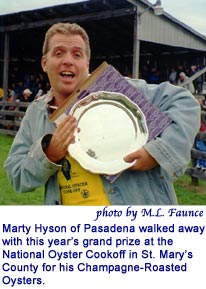 From soup to nuts, in this case pistachios, the annual National Oyster Cookoff in St. Mary’s County came off without a hitch. For a moment, though, there was reason to worry.
From soup to nuts, in this case pistachios, the annual National Oyster Cookoff in St. Mary’s County came off without a hitch. For a moment, though, there was reason to worry.
St. Mary’s County has been harvesting seafood for 300 years from rivers with names that drip history: the Patuxent, the Potomac. Flanked to the east by the bountiful Chesapeake Bay, this fertile southern Maryland peninsula was settled by English colonists seeking religious freedom. Along the way, oysters became a religion, too. In fact, the first English settlers were saved from starvation by a diet of Chesapeake oysters.
Back in the 1960s, the Rotarians of St. Mary’s County organized an annual festival to celebrate the bounty and to fund the organization’s high school scholarships and other good works. A decade later, a Rotarian with Good Housekeeping connections created the National Oyster Cookoff, bringing competitors from around the nation. This year’s contest drew recipes from such faraway places as West Palm Beach, Florida; Metaririe, Louisiana; and Clackamas, Oregon.
But in the 21st century, the oyster is no longer St. Mary’s — or Chesapeake Country’s — world. An all-time low is anticipated for this season’s harvest of wild oysters.
“Numbers tell the story,” says Chris Judy, Maryland Department of Natural Resources man on oysters. “The harvest for 2000 was 380,000 bushels; for 2001, 347,000 bushels; for 2002, 148,000 bushels. Anticipated for 2003, 50,000 bushels. Disease has had much impact on the population, accelerating tremendously because of the three-year drought.”
Still, at the Annual National Oyster Cookoff, oysters reign. Rotary’s immediate past president is proclaimed King Oyster. Crowned and clad in a red velvet cape, holding a staff encrusted with shells, the king walks among fairgoers, espousing the virtues and versatility of the real King Oyster. Annual festivities include the National Oyster Shucking Contest, with the winner meeting world-wide competition in Galway, Ireland.
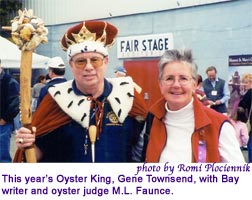 Accompanying all this activity, oysters are served to fairgoers in many ways — raw, scalded, frittered and fried — prepared by church groups and other local organizations. Keeping this show rolling calls for mountains of oysters.
Accompanying all this activity, oysters are served to fairgoers in many ways — raw, scalded, frittered and fried — prepared by church groups and other local organizations. Keeping this show rolling calls for mountains of oysters.
To fill that order, Rotarians and Optimists scoured the region for oysters. For most, they had to go as far as the Eastern Shore, but supplies were bounteous, satisfying fairgoers and the recipes to be made by the 12 finalists in the 23rd National Oyster Cookoff.
Five judges took on the succulent task of sampling the recipes of 12 contest finalists in four divisions: Hors d’oeuvres, Soups and Stews, Main Dishes and Outdoor Cookery and Salads. The fortunate five — including dinner designer William Taylor and food writer Ann Mackenzie, who have judged in all 23 cookoffs — risked their waistlines and whetted their pallets to do their duty sampling pearls of flavor.
Competing were seven women and five men, including two homegrown contestants, Brendan Cahill from Lusby and Sally Brassfield of Leonardtown. Among contestants, much was at stake. Many had faced off before, and some have traded awards back and forth. With a $1,000 grand prize, chefs were nervous as they prepared their dishes before the public eye in the fairgrounds kitchen. But who cooked what, no judge knew.
Before them were set oysters stuffed and nestled, teriyakied and pandowdied. Oysters grilled and seared, breaded and bare, dusted and roasted, smoked and skewered. Oysters creamed and coddled, dressed and diced. Oysters tangoed with mango and swam with crab sauce. Oysters peeked from baby pumpkins. And, in the case of the grand-prize winner, oysters came in the company of flutes of champagne.
Here’s how Marty Hyson of Pasadena won the grand prize:
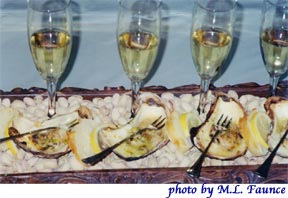 Champagne-Roasted Oysters
Champagne-Roasted Oysters
Smoke 12 shucked, champagne-soaked oysters on the half shell over mesquite chips on a hot grill for 10 minutes or until edges curl. Melt 1&Mac218;4-inch slice of lemon butter (made from two sticks butter, juice of one lemon, 1&Mac218;2 t garlic powder and 1 t basil) on each oyster. Sprinkle with crushed pistachios and reheat. Serve with champagne and French bread.
Feeling hungry? You can order your own copy of 2002 World Famous Award Winning Recipes from the 23rd Annual National Oyster Cookoff. Send a check for $4 to National Oyster Cookoff Cookbook, P.O. Box 653, Lenoardtown, MD 20650.
Feeling creative? Noreen Eberly, director of Maryland Deaprtment of Agriculture’s Aquaculture/Seafood Marketing, wants to hear from you. Eberly is already seeking recipes for next year’s National Oyster Cook-off on October 18, 2003. Many entrants, she notes, create and test their oyster recipes during the winter oyster season. Competition closes at the end of July.
Information? [email protected].
— M.L. Faunce
back to the top
Peace Walks Again
“Peace is a daily, a weekly, a monthly process, gradually changing opinions, slowly eroding old barriers, quietly building new structures.”
– John F. Kennedy
 People have never lacked reasons to walk for peace. They’ve walked to protest wars, to better international relations and to end domestic strife. It’s been a part of American heritage since the signing of the Declaration.
People have never lacked reasons to walk for peace. They’ve walked to protest wars, to better international relations and to end domestic strife. It’s been a part of American heritage since the signing of the Declaration.
Continuing the tradition, a community of Southern Marylanders gathers on three autumn Sundays in Solomons’ Glascock Field for a half-hour of reflection sponsored by the Patuxent Friends Meeting.
At the first walk, October 27, organizer Sara Ebenreck spoke to the gathering before it slipped into comfortable, thought-filled silence.
“Too often, peace is thought of as simply that quiet state that occurs after war, conflict or unrest,” she said. “But peace is much more than that. It arises from an intense and positive connection with the larger community.”
Edenbreck said this peaceful act could be seen as an alternative to more economic responses to the political situation with Iraq. But the walk made no political or religious protest, she said, instead serving to deepen internal awareness of the peace-making power.
“We’re really more focused on helping people with their own roles as peacemakers,” she said. To underscore the point, organizers banned signs and even message-bearing T-shirts from the event.
Some 70 people, from the young to the elderly, held hands and walked around a large circle drawn in the field. Most were southern Marylanders, but some came from Annapolis. Washington flutist Mark Guiffrida made soft background music for the meditations.
A quartet of self-described community activists from the Solomons area organize the walks. They reach out in local newspapers, post offices and e-mail listserves.
“No doubt, a small number of peaceful people can make a difference. What we focus on expands,” said Tracey Eno, another organizer.
Join the walk November 10 and Devember 15, rain or shine, from 2-2:30pm at Glascock Field, across from Calvert Marine Museum, Solomons.
Information? 410/414-5266.
— Sarah Williams
back to the top
Where No Bus Has Gone Before
City buses are a rare sight in Annapolis. A handful wind along six local routes — each named for a color — forming a figure eight between Eastport and Annapolis Mall. A seventh route, the Sky Blue, has carried passengers to BWI Airport and Arundel Mills for a year now. Besides the Sky Blue, Annapolis buses have never been seen on county roads.
That will change in January, when two buses begin roving 30 miles up and down Route 2, from Arnold in the north to Edgewater in the south. The buses will pick up passengers at South River Colony, South River High School, the Center of Applied Technology, the South County Senior Center as well as the Spa Road transfer point, then cut across Annapolis and the Naval Academy Bridge before continuing up Route 2 to Anne Arundel Community College.
The new C-40 route (C is for county) will operate 7am to 7pm weekdays only, and will cost $1.50 per trip. With more buses on line, Annapolis Transit’s ridership has doubled in the past five years, and the agency expects 13,650 passengers to ride the new route by June. Many depend entirely on public transportation.
“One-third of the Maryland state population is not licensed to drive,” says Ginger Doyel of the Annapolis Department of Transportation. “Sixty percent of Maryland state spending on transportation goes toward highway construction and maintenance. State transportation funds are not meeting the needs of a significant segment of the population.”
People who don’t drive are even more neglected in Anne Arundel County, where the lion’s share of taxpayer dollars funds the needs of motorists. Besides leaving thousands stranded, current budgeting contributes to Anne Arundel’s environmental woes.
“It’s shocking,” Doyel says, “that a county with such sobering air pollution — much of which is due to vehicular emissions — does not support public transit and instead spends 89 percent of its transportation funds on increasing roadways and bridges.”
The new bus route is the first the county has agreed to fund. Fares and advertising revenue will cover about one-quarter of the route’s operating costs through June, leaving $85,586. The Federal Transit Administration will cover half that amount and Anne Arundel the remainder.
“By making public transit a priority,” Doyel says, “the county can actively prevent the congestion and environmental pollution present in Annapolis from forming in Edgewater and further south.”
Annapolis Mayor Ellen Moyer agrees that public transit contributes to a healthier environment.
“Every bus customer represents less traffic, less congestion and less air pollution,” Moyer says. “The City of Annapolis is pleased to provide this service and grateful that Anne Arundel County is providing the full local share.”
The only complaint, Doyel says, is “the route will not go far enough.” But she says the county’s new level of commitment to public transportation holds promise: “C-40 is laying the foundation for a county-wide transit authority.”
Annapolis Transit welcomes your ideas and opinions. Tell Doyel what bus service you need before Nov. 22 at 410/263-7964 x 107 • [email protected].
— Brent Seabrook
back to the top
Way Downstream …
In Virginia, they’re trying to keep up with Maryland in tall ships, too. Last month, dozens of supporters and investors turned out in Norfolk at the keel-laying ceremony for a $3.2 million, 122-foot replica of the 1917 schooner Virginia. It will be a tall ship indeed with a mast that reaches 105 feet above the waterline …
In Minnesota, environmentalists had special reasons to grieve the death of Sen. Paul Wellstone in a plane crash. He was an unfailing advocate of protections for land and water, as Sierra Club president Carl Pope noted. “Paul wrestled with corporations who thought they could pollute at will and abuse workers with impunity,” he said …
 Our Creature Feature comes from California, where there’s new evidence that sea lions might have better memories than almost any other creatures and perhaps some humans.
Our Creature Feature comes from California, where there’s new evidence that sea lions might have better memories than almost any other creatures and perhaps some humans.
Ten years ago, marine biologists at the University of California at Santa Cruz taught a sea lion named Rio to match numbers and letters on cards in return for fish. Recently, Rio performed the same trick without seeing the cards in a decade, New Scientist magazine reported this week.
back to the top